|
|
||
|
|
|||

|
|
|
|
The Beginning What has developed into today's art museum at Michigan State University appeared in 1930 when the then Art Department first began to publicly display various art works. Not having a permanent home, for many years that small collection bounced around the campus including stints in the Union, Morrill Hall and even in eight temporary army Quonset huts. In 1945, three Mexican retablos were donated to the Art Department thereby establishing the "official" art collection at the University. Records for the early history of the collection from 1950 to 1963 do not exist although approximately 176 objects are known to have been received during those years. Fund allotments were provided by MSU alumni to make purchases through small committees elected by the Art Department staff. Such committee purchases were enormously important in the shaping of the collection. In 1956, Potato Farmscape No. 5 by Abraham Rattner was the first American painting to enter the collection. Another major addition, Salvador Dali's Remorse or Sphinx Embedded in the Sand, dated 1931, was donated by John Wolfram in 1961. The work is now perhaps the Museum's best known painting. A New Building & Full Time Director
Collection Expansion The collection grew quickly especially in the period from 1965 to 1968. A three-year plan was established in which a sizable allotment of funds was set aside each year for the purchase of art. This sum was to be used to expand the collection in areas that were not yet represented. In 1965 over 215 pieces entered the collection, ranging from an Egyptian shawabti to a Tibetan temple banner, from Japanese eighteenth and nineteenth century prints to a Blakelock painting and Jim Dine prints. Also in these years the Museum received many donations from artists facilitated by Art Professor Charles Pollock, older brother of Jackson Pollock, and his friend and eminent critic Clement Greenberg. The nucleus of the Museum's strong holdings in 1960s Abstract Expressionism and Post-Painterly Abstraction was formed in this way and includes Alpha Theta by Morris Louis, Bell by Kenneth Noland, Olivet Sun Box by Theodoros Stamos, and an untitled oil on paper by Helen Frankenthaler. By 1969, the program of directed buying ceased with the curtailment of University funds for acquisitions. Nevertheless, donations continued and, by 1971, the collection had more than doubled in size, growing to 830 objects. When Paul Love retired in June 1974, he was proud to have added to the collection works as diverse as Durer's Nemesis, Cezanne's color lithograph of the Large Bathers, and San Isidoro, the late fourteenth century Spanish wooden seated bishop. Friends of Kresge
Friends has been instrumental in establishing the Friends Endowment for Acquisitions and Conservation, The Kresge Art Museum Education Endowment, KAM Ambassadors and the Kresge Art Museum Facilities Fund. Through the Ambassadors, hundreds of people have been informed about Museum exhibitions, public programs, special events and one-of-a-kind trips. The Friends Trips and Tours program continues to provide exciting and educational arts-related excursions both in the United States and abroad. Kresge Art Museum - Officially In 1984, to reflect the changed status of the MSU art collection and the increased professionalism of the staff, the "Gallery", which had already been accredited by the American Association of Museums in 1973, was officially recognized by the University's Board of Trustees as the "Kresge Art Museum". The Museum has been reaccredited twice since then, meeting ever-increasing expectations of excellence in programming, exhibits and collections. 1986 to Present
Docent Program To further the Museum's emphasis on education, a docent program was established in 1976. Currently, under the direction of Dr. Carol Fisher, the program is made up of more than 90 volunteer members. All docents receive nine months of initial training including lectures, reading assignments in art history and touring etiquette and technique. Periodic training is also conducted to keep docents abreast of new acquisitions and new displays and exhibits. Tours are given to adults, university students and school groups from the mid-Michigan area. More than 6000 university students have completed course related projects at the Museum. And each year, more than 5000 area school children come to the Museum for docent-led tours. Docents also travel to area senior centers and homes to give slide presentations.
The Museum also subsidizes the cost of busing students to and from the Museum. These funds are provided by the Dart Foundation and the KAM Education Endowment Fund. BAM Committee In 1999 a campaign was started to pursue a much needed museum expansion and a committee for a bigger and better art museum was formed. The committee, known as BAM (Bigger Art Museum, Better Art Museum), is deeply committed and involved in a wide array of activities to insure the expansion's success. Educational and fundraising events, publications about the Museum expansion and this website are but a few examples of the BAM Committee's efforts. Please see the About BAM page for more information. Facilities Fund In June of 2000 the MSU Board of Trustees established the Kresge Art Museum Facilities Fund for the purpose of accumulating donated funds for expanded or improved facilities to meet the program needs of the Museum. Currently, increasing this fund is the focus of The Friends of Kresge and the BAM Committee. For ways you can help, please click here. To see more historical photos, click here. |
|
|
Copyright @ 2003 All Rights Reserved |
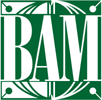

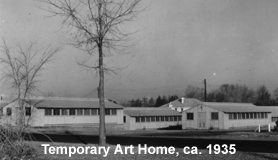
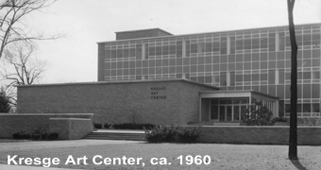 In
1959, with the backing of the Kresge Foundation, a new building,
the Kresge Art Center, was constructed for the Art Department and
a small area known as the Gallery was established near the front
to house the collection. Shortly after the opening of the new building
it became apparent that a professional full-time director was needed.
Eventually, in the fall of 1963, Dr. Paul Love was appointed to
this position. At this point there were 355 pieces in the collection,
including prints, drawings, paintings, and sculpture. In 1967 a
small expansion of the Gallery was added on the north end of the
building to provide more exhibit space.
In
1959, with the backing of the Kresge Foundation, a new building,
the Kresge Art Center, was constructed for the Art Department and
a small area known as the Gallery was established near the front
to house the collection. Shortly after the opening of the new building
it became apparent that a professional full-time director was needed.
Eventually, in the fall of 1963, Dr. Paul Love was appointed to
this position. At this point there were 355 pieces in the collection,
including prints, drawings, paintings, and sculpture. In 1967 a
small expansion of the Gallery was added on the north end of the
building to provide more exhibit space.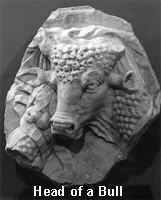 In
1975, Love's successor, Joseph Ishikawa, developed the Friends of
Kresge, a membership and volunteer group whose purpose is to provide
for and support community visual arts education and raise funds
for Museum acquisitions and improvements of the Museum facility.
In 1976, Friends funded their first acquisition, a sixth century
BCE Greek ceramic neck amphora. Since then they have funded the
acquisition of over 30 major pieces of art including a sound piece
by Henry Bertoia, acquired in 1979; an example of rare and colorful
vases from Centuripe in Sicily dating to the third century BCE,
purchased in 1983; Rodin's bronze Flying Figure; the fifteenth
century Siennese tempera on wood triptych of the Crucifixion by
Paolo di Giovanni Fei; a second century CE Roman sculpture, head
of a bull, purchased in 1994; and most recently in 2002, Meyerowitz's
New York City (Blue Hour).
In
1975, Love's successor, Joseph Ishikawa, developed the Friends of
Kresge, a membership and volunteer group whose purpose is to provide
for and support community visual arts education and raise funds
for Museum acquisitions and improvements of the Museum facility.
In 1976, Friends funded their first acquisition, a sixth century
BCE Greek ceramic neck amphora. Since then they have funded the
acquisition of over 30 major pieces of art including a sound piece
by Henry Bertoia, acquired in 1979; an example of rare and colorful
vases from Centuripe in Sicily dating to the third century BCE,
purchased in 1983; Rodin's bronze Flying Figure; the fifteenth
century Siennese tempera on wood triptych of the Crucifixion by
Paolo di Giovanni Fei; a second century CE Roman sculpture, head
of a bull, purchased in 1994; and most recently in 2002, Meyerowitz's
New York City (Blue Hour).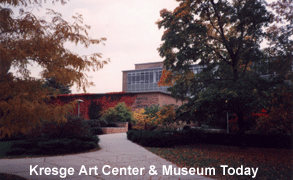 Mr.
Ishikawa retired in 1986 and was succeeded by Dr. Susan Bandes,
the third and present director. Under the direction of Dr. Bandes
and her experienced and knowledgeable staff, the Museum has continued
to grow and develop. Through their research and recommendations
and funds provided by the Friends of Kresge as well as over $2.5
million in acquisition endowments, the Museum continues to add to
its collection which now numbers over 7,000 pieces. The number of
Museum personnel has increased and a curatorial staff has been established.
Public and educational programs, circulating exhibitions from the
collection and community connections have also expanded significantly.
Mr.
Ishikawa retired in 1986 and was succeeded by Dr. Susan Bandes,
the third and present director. Under the direction of Dr. Bandes
and her experienced and knowledgeable staff, the Museum has continued
to grow and develop. Through their research and recommendations
and funds provided by the Friends of Kresge as well as over $2.5
million in acquisition endowments, the Museum continues to add to
its collection which now numbers over 7,000 pieces. The number of
Museum personnel has increased and a curatorial staff has been established.
Public and educational programs, circulating exhibitions from the
collection and community connections have also expanded significantly.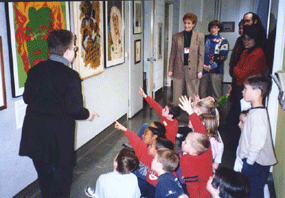 Tours
for area schools are designed to stimulate students' interest in
art and expand their critical thinking skills through a variety
of activities. Special programs and thematic tours that relate to
the school curriculum have been prepared. Emphasis on discovering
color, shape, line, texture, painting and sculpture is given to
students in grades K through 5 respectively. Additionally, a new
"Art for a New Nation" tour, geared to Michigan curriculum
guidelines, is now being presented to grade 5. By examining and
discussing works of art, students learn about the American artistic
heritage that developed out of immigrations to this country from
Europe, Africa, Meso-America and Asia, and receive a taste of Native
American culture. Arts and Humanities tours for middle and high
schools coordinate with history, English, language, social studies
and art curricula.
Tours
for area schools are designed to stimulate students' interest in
art and expand their critical thinking skills through a variety
of activities. Special programs and thematic tours that relate to
the school curriculum have been prepared. Emphasis on discovering
color, shape, line, texture, painting and sculpture is given to
students in grades K through 5 respectively. Additionally, a new
"Art for a New Nation" tour, geared to Michigan curriculum
guidelines, is now being presented to grade 5. By examining and
discussing works of art, students learn about the American artistic
heritage that developed out of immigrations to this country from
Europe, Africa, Meso-America and Asia, and receive a taste of Native
American culture. Arts and Humanities tours for middle and high
schools coordinate with history, English, language, social studies
and art curricula.